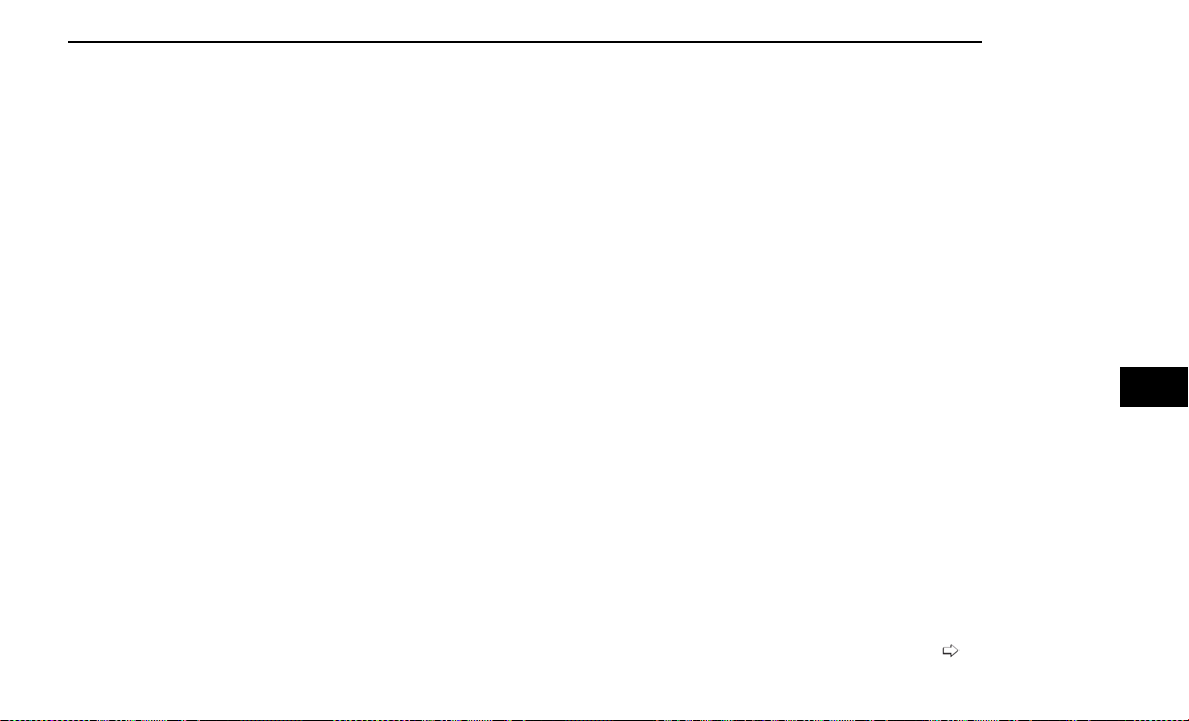Loading ...
Loading ...
Loading ...

When Tire Fill Alert mode is entered, the tire pressure
display screen will be displayed in the instrument
cluster.
Operation:
•
The horn will chirp once to let the user know when
to stop filling the tire, when it reaches recom-
mended pressure.
•
The horn will chirp three times if the tire is overfilled
and will continue to chirp every five seconds if the
user continues to inflate the tire.
•
The horn will chirp once again when enough air is let
out to reach proper inflation level.
•
The horn will also chirp three times if the tire is then
underinflated and will continue to chirp every five
seconds if the user continues to deflate the tire.
Selectable Tire Fill Alert (STFA) —
If Equipped
The Selectable Tire Fill Alert (STFA) system is an
optional feature that is included as part of the normal
Tire Fill Alert system. The system is designed to allow
you to select a pressure to inflate or deflate the vehi-
cle's front and rear axle tires to, and to provide feed-
back while inflating or deflating the vehicle's tires.
In the Selectable Tire Fill Alert application, which is
located in the apps menu of the Uconnect system, you
will be able to select a pressure setting for both the
front and rear axle tire pressures by scrolling through a
pressure range from greater than or equal to 15 psi to
XX psi in 1 psi increments for each axle setting.
XX = the vehicle's cold placard pressure values for the
front and rear axles as shown on the vehicle placard
pressure label.
You may also store pressure values chosen for each
axle in the Uconnect system application as preset pres-
sure values. Up to two sets of preset pressure values
can be stored in the Uconnect system for the front and
rear axle. Once you select the tire pressures for the
front and rear axles that you want to inflate or deflate
to, you can begin inflating or deflating one tire at a
time.
NOTE:
The STFA system will only support inflating or deflating
one tire at a time. The user is required to wait until the
hazard lights STOP flashing or 26-30 seconds after the
desired pressure is achieved in one wheel, before
switching to another.
The system will be activated when the TPMS receiver
module detects a change in tire pressure. The ignition
must be in the ON/RUN mode, with the transmission in
PARK. The hazard lights will come on to confirm the
vehicle is in Tire Fill Alert mode.
When Tire Fill Alert mode is entered, the tire pressure
screen will be displayed in the instrument cluster. If the
hazard lights do not come on while inflating or deflating
the tire, the Tire Pressure Monitoring System sensor
may be in an inoperative position, preventing the TPMS
sensor signal from being received. In this case, the
vehicle may need to be moved slightly forward or
backward.
Horn chirps will indicate STFA status as tires are
inflated/deflated. The horn will chirp under the follow-
ing STFA states:
1. The horn will chirp once when the selected pressure
is reached to let you know when to stop inflating or
deflating the tire.
2. The horn will chirp three times if the tire is overin-
flated or over-deflated.
3. The horn will chirp once again when enough air is
added or removed to reach proper selected pres-
sure level.
OCCUPANT RESTRAINT SYSTEMS
Some of the most important safety features in your
vehicle are the restraint systems:
OCCUPANT RESTRAINT SYSTEMS
FEATURES
•
Seat Belt Systems
•
Supplemental Restraint Systems (SRS) Air Bags
•
Child Restraints
Some of the safety features described in this section
may be standard equipment on some models, or may
be optional equipment on others. If you are not sure,
ask an authorized dealer.
IMPORTANT SAFETY PRECAUTIONS
Please pay close attention to the information in this
section. It tells you how to use your restraint system
properly, to keep you and your passengers as safe as
possible.
Here are some simple steps you can take to minimize
the risk of harm from a deploying air bag:
1. Children 12 years old and under should always ride
buckled up in the rear seat of a vehicle with a rear
seat.
2. A child who is not big enough to wear the vehicle
seat belt properly must be secured in the appropri-
ate child restraint or belt-positioning booster seat in
a rear seating position
page 260.
SAFETY 243
6
Loading ...
Loading ...
Loading ...